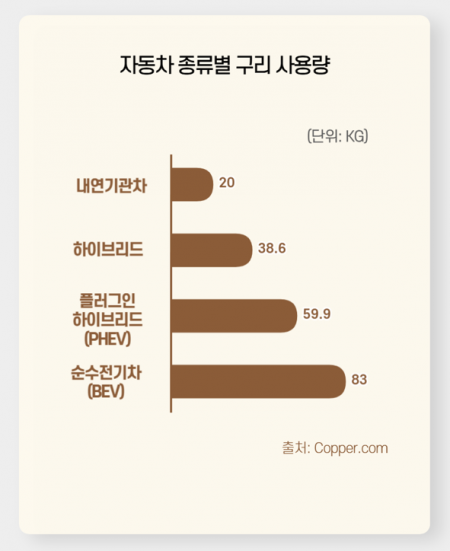Electric vehicles use 2-4 times more copper than internal combustion cars
Excellent electrical and thermal conductivity; can be recycled repeatedly
Copper demand for 'AI data centers' expected to increase sixfold by 2050
"Policy support needed for stable copper supply"
Copper products. Getty Images Bank
According to industry sources on the 14th, 'copper', once considered a material for power transmission and telegraph wires, is emerging as a key material in advanced industries. Today, as electric vehicles run on roads, artificial intelligence (AI) processes vast amounts of data, and the defense industry becomes more advanced, copper plays a role in supporting the flow of advanced industries. Copper is characterized by its excellent electrical and thermal conductivity, as well as mechanical reliability that is maintained even in extreme environments. Additionally, it can be repeatedly recycled without quality degradation, making it the most practical material in the process of energy transition and future industrial infrastructure construction.
Copper usage in electric vehicles 2-4 times that of internal combustion vehicles... Demand for AI and defense products also increasing
An average of 60-80 kg of copper is used in one electric vehicle. This is about 2-4 times the amount used in internal combustion vehicles. Copper is used in all components where electricity flows, such as battery cells and packs, motor windings, high-current wiring, cooling systems, and charging infrastructure. Copper has about 40% lower conduction loss than aluminum and higher thermal conductivity, which helps reduce heat generation. It is known as a material that improves both the efficiency and lifespan of electric vehicle batteries. The International Energy Agency (IEA) forecasts that copper demand will reach an all-time high by 2035 due to the expansion of electric vehicle distribution. It is analyzed that the growth curve of the electric vehicle industry will show a similar trend to that of the copper industry.

Recently, AI data centers, which have rapidly increased and have high power demand, also require copper. Copper is used in almost all elements that make up the power and signal paths of data centers, such as power grids, substations, ultra-high-density server racks, cooling facilities, and communication lines. Copper's unique high conductivity increases power efficiency and prevents server overheating, thereby extending system lifespan. Global mining company BHP forecasts that copper demand for data centers will increase approximately sixfold to 3 million tons by 2050.
Copper products. Getty Images Bank
Pouring liquid copper into a mold. Getty Images Bank
Copper is also an essential material in the strategic defense industry sector. Defense industry products such as fighter jets, ships, radar, and communication equipment are used in extreme situations, requiring high mechanical reliability. Copper is suitable for building high-reliability power systems needed for defense products as it can stably control strong currents and electromagnetic waves. It is also resistant to corrosion, maintaining equipment lifespan and performance stably in harsh environments such as salinity, vibration, and high heat.
"The most practical resource in the era of sustainability"
Copper's recyclability is also noteworthy. According to the International Copper Association (ICA), about 32% of global copper demand is from recycled products. Recycling can reduce energy use by about 85% compared to primary production, naturally contributing to carbon emission reduction. It can be repeatedly recycled without quality degradation, making it a representative resource in a sustainable circular economy system. However, challenges such as energy consumption in the recycling process, establishing electronic waste recovery systems, and developing new mines need to be addressed. Nevertheless, with technological innovation and policy support, copper is still evaluated as the most practical resource that can simultaneously meet the three goals of power grid efficiency, economic viability, and sustainability.
Copper products. Getty Images Bank
Yoo Han-jong, head of the International Copper Association's branch, stated, "Copper is not only supporting various fields from electric vehicles to AI, renewable energy, and the defense industry but also accelerating innovation and development by changing the industrial landscape itself." He added, "The industry should focus on stabilizing copper supply and diversifying supply chains in the short term, while investing in recycling technology and devising efficient resource utilization plans in the medium to long term." He emphasized, "To realize a sustainable industrial ecosystem, policy support such as developing eco-friendly mining technologies and establishing waste recovery systems is also necessary."
ⓒ dongA.com. All rights reserved. Reproduction, redistribution, or use for AI training prohibited.
Popular News
